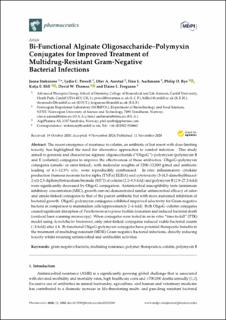| dc.contributor.author | Stokniene, Joana | |
| dc.contributor.author | Powell, Lydia C. | |
| dc.contributor.author | Aarstad, Olav Andreas | |
| dc.contributor.author | Aachmann, Finn Lillelund | |
| dc.contributor.author | Rye, Philip D | |
| dc.contributor.author | Hill, Katja E. | |
| dc.contributor.author | Thomas, David W. | |
| dc.contributor.author | Ferguson, Elaine L. | |
| dc.date.accessioned | 2022-12-08T09:29:17Z | |
| dc.date.available | 2022-12-08T09:29:17Z | |
| dc.date.created | 2021-01-10T17:17:27Z | |
| dc.date.issued | 2020 | |
| dc.identifier.citation | Pharmaceutics. 2020, 12 (11), 1-21. | en_US |
| dc.identifier.issn | 1999-4923 | |
| dc.identifier.uri | https://hdl.handle.net/11250/3036674 | |
| dc.description.abstract | The recent emergence of resistance to colistin, an antibiotic of last resort with dose-limiting toxicity, has highlighted the need for alternative approaches to combat infection. This study aimed to generate and characterise alginate oligosaccharide (“OligoG”)–polymyxin (polymyxin B and E (colistin)) conjugates to improve the effectiveness of these antibiotics. OligoG–polymyxin conjugates (amide- or ester-linked), with molecular weights of 5200–12,800 g/mol and antibiotic loading of 6.1–12.9% w/w, were reproducibly synthesised. In vitro inflammatory cytokine production (tumour necrosis factor alpha (TNFα) ELISA) and cytotoxicity (3-(4,5-dimethylthiazol-2-yl)-2,5-diphenyltetrazolium bromide (MTT) of colistin (2.2–9.3-fold) and polymyxin B (2.9–27.2-fold) were significantly decreased by OligoG conjugation. Antimicrobial susceptibility tests (minimum inhibitory concentration (MIC), growth curves) demonstrated similar antimicrobial efficacy of ester- and amide-linked conjugates to that of the parent antibiotic but with more sustained inhibition of bacterial growth. OligoG–polymyxin conjugates exhibited improved selectivity for Gram-negative bacteria in comparison to mammalian cells (approximately 2–4-fold). Both OligoG–colistin conjugates caused significant disruption of Pseudomonas aeruginosa biofilm formation and induced bacterial death (confocal laser scanning microscopy). When conjugates were tested in an in vitro “time-to-kill” (TTK) model using Acinetobacter baumannii, only ester-linked conjugates reduced viable bacterial counts (~2-fold) after 4 h. Bi-functional OligoG–polymyxin conjugates have potential therapeutic benefits in the treatment of multidrug-resistant (MDR) Gram-negative bacterial infections, directly reducing toxicity whilst retaining antimicrobial and antibiofilm activities. | en_US |
| dc.language.iso | eng | en_US |
| dc.publisher | MDPI | en_US |
| dc.rights | Navngivelse 4.0 Internasjonal | * |
| dc.rights.uri | http://creativecommons.org/licenses/by/4.0/deed.no | * |
| dc.title | Bi-functional alginate oligosaccharide–polymyxin conjugates for improved treatment of multidrug-resistant gram-negative bacterial infections | en_US |
| dc.title.alternative | Bi-functional alginate oligosaccharide–polymyxin conjugates for improved treatment of multidrug-resistant gram-negative bacterial infections | en_US |
| dc.type | Peer reviewed | en_US |
| dc.type | Journal article | en_US |
| dc.description.version | publishedVersion | en_US |
| dc.source.pagenumber | 1-21 | en_US |
| dc.source.volume | 12 | en_US |
| dc.source.journal | Pharmaceutics | en_US |
| dc.source.issue | 11 | en_US |
| dc.identifier.doi | 10.3390/pharmaceutics12111080 | |
| dc.identifier.cristin | 1868366 | |
| dc.relation.project | Norges forskningsråd: 226244 | en_US |
| cristin.ispublished | true | |
| cristin.fulltext | original | |
| cristin.qualitycode | 1 | |

